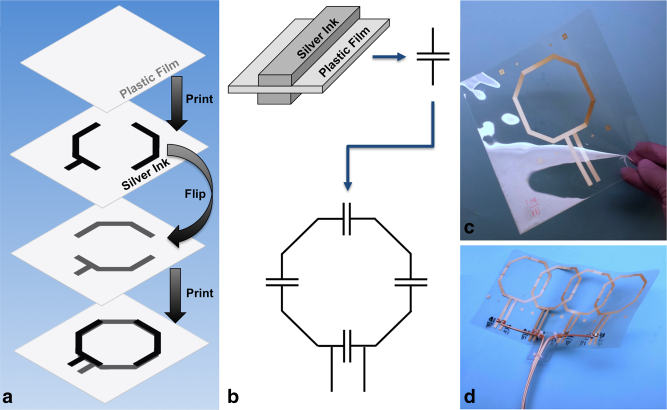Joe and Balthazar’s paper on materials and methods for higher performance screen-printed flexible MRI receive coils in Magnetic Resonance in Medicine. Congrats!!!
Paper title: Materials and Methods for Higher Performance Screen-Printed Flexible MRI Receive Coils
Abstract: Purpose
To develop methods for characterizing materials used in screen-printed MRI coils and improve signal-to-noise ratio (SNR) with new lower-loss materials.
Methods
An experimental apparatus was created to characterize dielectric properties of plastic substrates used in receive coils. Coils were fabricated by screen printing conductive ink onto several plastic substrates. Unloaded and sample loaded quality factor (QUnloaded/QLoaded) measurements and scans on a 3T scanner were used to characterize coil performance. An experimental method was developed to describe the relationship between a coil’s QUnloaded and the SNR it provides in images of a phantom. In addition, 3T scans of a phantom and the head of a volunteer were obtained with a proof-of-concept printed eight-channel array, and the results were compared with a commercial 12-channel array.
Results
Printed coils with optimized substrates exhibited up to 97% of the image SNR when compared with a traditional coil on a loading phantom. QUnloaded and the SNR of coils were successfully correlated. The printed array resulted in images comparable to the quality given by the commercial array.
Conclusion
Using the proposed methods and materials, the SNR of printed coils approached that of commercial coils while using a new fabrication technique that provided more flexibility and close contact with the patient’s body.
Publication:
-

Materials and Methods for Higher Performance Screen-Printed Flexible MRI Receive Coils
Joseph R. Corea,
P. Balthazar Lechene,
Michael Lustig,
and
Ana C. Arias
Magnetic Resonance in Medicine,
2016
[Abstract]
[Bibtex]
[PDF]
Purpose
To develop methods for characterizing materials used in screen-printed MRI coils and improve signal-to-noise ratio (SNR) with new lower-loss materials.
Methods
An experimental apparatus was created to characterize dielectric properties of plastic substrates used in receive coils. Coils were fabricated by screen printing conductive ink onto several plastic substrates. Unloaded and sample loaded quality factor (QUnloaded/QLoaded) measurements and scans on a 3T scanner were used to characterize coil performance. An experimental method was developed to describe the relationship between a coils QUnloaded and the SNR it provides in images of a phantom. In addition, 3T scans of a phantom and the head of a volunteer were obtained with a proof-of-concept printed eight-channel array, and the results were compared with a commercial 12-channel array.
Results
Printed coils with optimized substrates exhibited up to 97% of the image SNR when compared with a traditional coil on a loading phantom. QUnloaded and the SNR of coils were successfully correlated. The printed array resulted in images comparable to the quality given by the commercial array.
Conclusion
Using the proposed methods and materials, the SNR of printed coils approached that of commercial coils while using a new fabrication technique that provided more flexibility and close contact with the patients body. Magn Reson Med, 2016. _ 2016 International Society for Magnetic Resonance in Medicine
@article{corea2016materials,
author = {Corea, Joseph R. and Lechene, P. Balthazar and Lustig, Michael and Arias, Ana C.},
title = {Materials and Methods for Higher Performance Screen-Printed Flexible MRI Receive Coils},
journal = {Magnetic Resonance in Medicine},
issn = {1522-2594},
url = {http://dx.doi.org/10.1002/mrm.26399},
doi = {10.1002/mrm.26399},
pages = {n/a--n/a},
keywords = {MRI coils, flexible MRI coils, phased arrays, NMR probes, screen printing, plastic substrates},
year = {2016},
thumbnail = {corea2016materials.png},
pdf = {corea2016materials.pdf}
}
 Materials and Methods for Higher Performance Screen-Printed Flexible MRI Receive Coils Magnetic Resonance in Medicine, 2016 [Abstract] [Bibtex] [PDF]
Materials and Methods for Higher Performance Screen-Printed Flexible MRI Receive Coils Magnetic Resonance in Medicine, 2016 [Abstract] [Bibtex] [PDF]